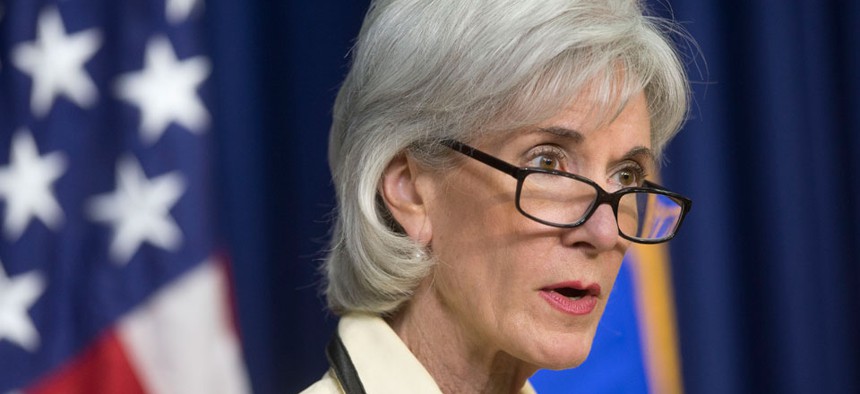
Pablo Martinez Monsivais/AP
HHS Secretary Defends Healthcare.gov, Obamacare to Mayors
Kathleen Sebelius tells a somewhat skeptical group of local leaders that enrollment in Affordable Care Act is up to 9 million.
Health and Human Services Secretary Kathleen Sebelius touted the current healthcare.gov website as much-improved from the balky site that millions struggled to navigate in October, during a discussion with a gathering of mayors in Washington on Wednesday.
Asked by Green Bay, Wis., Mayor James Schmitt for comment on the botched website rollout, Sebelius said, “The first several weeks were rocky, to say the least, but we committed to a vastly different user experience by Nov. 30, and we were able to do that.” Now the site doesn’t crash, and the average enrollee can sign up in 20 minutes from start to finish, she said.
Parts of the website that are not “consumer-facing,” she added, such as the paper-dependent process in which an applicant’s declaration of income is cross-checked with the Internal Revenue Service and elsewhere, are still in the process of being completed. In some cases, it’s the states that are not ready for the linkup, Sebelius said.
HHS has re-contacted users who tried unsuccessfully in October to use the website and urged them to try again, she said, noting that her department has 2,000 “trained helpers” standing by. “We never thought all people would use the website.”
Addressing a sometimes-skeptical audience at a breakout session of the U.S. Conference of Mayors annual winter meeting, the former Kansas governor praised mayors for being “pragmatic CEOs at the forefront” of tackling the country’s health care problems, in particular on issues such as substance abuse, obesity and in providing a strong voice in the state legislatures for Medicaid expansion under the Affordable Care Act.
She spoke just as the Centers for Medicare and Medicaid Services reported that between October and December more than 6.3 million individuals were eligible to enroll in Medicaid or the Children’s Health Insurance Program through state agencies and through the state-based marketplaces. That brings the total enrolled under the umbrella of the healthcare law to 9 million, the secretary said, including 2.1 million in private plans through the exchanges.
Two new polls, Sebelius said, show that many uninsured remain unaware of Obamacare’s benefits or that they might qualify for subsidies, which gives her hope that many will come around before the March 31 deadline for open enrollment. “Six in 10 people can get covered for $100 a month or less, which is often cheaper than a cellphone bill, but also provides peace of mind,” Sebelius said. She was equally encouraged by the $151 million in grants for health care community health centers announced in November, which could help enroll 1.25 million additional patients. Sebelius pointed out that mayors pay much of the $326 billion in uncompensated emergency room care that hospitals have racked up since 2000.
The 2010 health law’s offer of funding for states that choose to expand Medicaid (23 states, run largely by Republicans, have rejected it) is “the most generous federal-state partnership I’ve seen,” Sebelius said, declaring that the money is already budgeted, and that states that accept it will not pay more than 10 percent of the cost for a decade.
Mark Lauretti, the mayor of Shelton, Conn., expressed frustration during Wednesday’s discussion that he has not gotten a straight answer on whether small employers with many part-time workers in their 20s are required to provide health coverage. Sebelius said she couldn’t provide policy details on the spot, but would later, reiterating the law’s provisions that people up to age 26 can stay on their parents’ health plan, that companies with fewer than 50 employees are not required to provide coverage, and that seasonal jobs, such as those at ski resorts, are not considered full-time when calculating the 50-worker cutoff.
NEXT STORY: Creating a Culture of Helping







